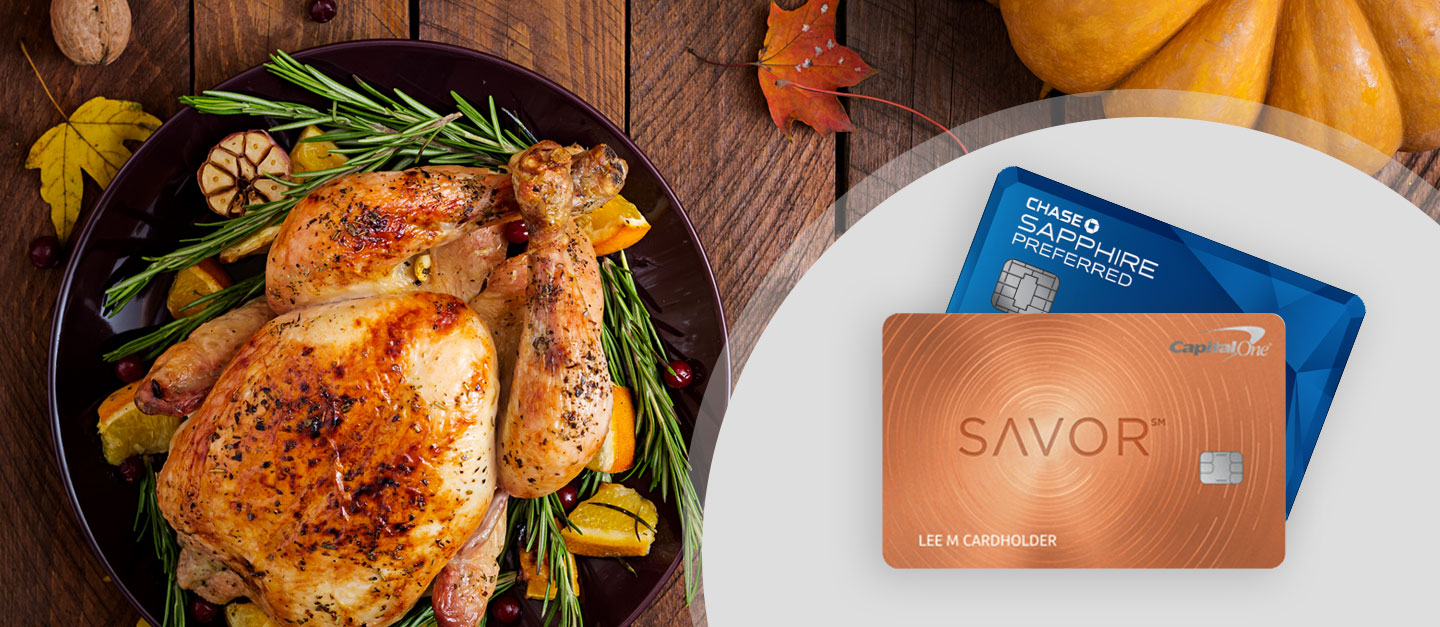
We’re well into the Month of the Turkey – the month in which everyone’s thoughts turn to eating and shopping.
We have Thanksgiving barreling toward us, with Christmas waiting right around the corner.
All of which means lots of spending happens between now and the new year … and that means now’s a perfect time to consider a credit card that
These days, lots and lots of credit cards are designed with a specific benefit: the accumulation of
What we want to focus on, though, are all-purpose credit cards that are great for shopping, or those that offer substantial rewards for dining out, since there’s a lot of dining away from home that happens over the next two months.
Let’s start with…
The Best All-Purpose Credit Cards
In this category, I am including cards that excel for general shopping, as well as groceries. Thanksgiving, obviously, is all about the food – the turkey, the sweet potatoes, the stuffing, etc.
We have to lead with Blue Cash Preferred from American Express.
Frankly, there’s not another credit card I’ve come across that is as beneficial as this one is for spending on groceries.
Amex Blue Cash Preferred gives you a whopping 6% cash back on groceries on the first $6,000 you spend every year at a grocery store.
Once you exceed $6,000, the cash back rate falls to 1%. But given that the Bureau of Labor Statistics finds that the average American family spends between $290 and $500 a month at the supermarket (depending on geography) you’re looking at 6% cash back for every grocery trip you make during the year, or almost all them at the very least.
Besides the grocery benefit, Amex Blue Cash Preferred will give you 6% cash back on streaming services (so you can fall asleep in front on Netflix after loading up on turkey), and 3% for transit and gas stations (for all the driving back and forth to the supermarket and the mall over the next couple of months). Everything else earns cash back at a 1% rate.
And you’re going to pick up a $250 statement credit when you spend $1,000 in the first three months. The average American family spends about $190 on Thanksgiving, according to research from LendEDU, so you should easily recoup your Turkey Day expenses with your cash back bonus.
Amex Blue imposes a $95 annual fee.
Best Branded Credit Card
If you are a truly dedicated Target shopper, then the Target RedCard is another great option, particularly if you set up a subscription for regular delivery of groceries to your home. But you need to understand a couple of caveats.

First, the benefit of the Target RedCard is that you get a 5% discount on whatever you buy at Target – in store or online.
Second, if you set you a subscription for regularly delivery of groceries to your home, you can get an additional 5% off. So, basically, you’re collecting 10%.
Beyond that, you’ll get 5% of your order at Starbucks stores located inside Target, as well as 10% off on the anniversary of your card.
However, there are two caveats to know about…
This is not a traditional credit card issued by Visa, Mastercard or Amex. It’s a Target-only store card. So you cannot use the card anywhere else on the planet but Target.
Moreover, this is not a cash back card. You’re simply getting a discount at checkout, so the money savings come directly off your purchase at the moment. That’s not a bad thing – 10% is 10% regardless of how you get it. But I know some people like the cash back option because they like to set that money aside for a specific purpose, such as a vacation.
Target RedCard has no annual fee, and you will pick up a $25 coupon after spending $100 or more.
Best CashBack Credit Card
With Bank of America Cash Rewards, you’re getting 3% cash back on whatever category you choose. These will be excellent for your overall non-grocery shopping. The categories include: Gas, online shopping, dining (for those pre- and post-Thanksgiving meals away from home) and transit, drug stores and home-improvement outlets.

You can change categories as needed each month, or leave it unchanged.
In addition, you’ll pick up 2% cash back on your grocery shopping and shopping at wholesale clubs. The 3% and 2% cash back bonuses are on the first $2,500 in combined spending each quarter, which, honestly, should easily cover most family budgets. (Note: if you have a Bank of America personal checking account, or at least $20,000 in certain BofA bank accounts or a Merrill Lynch investment account, your 3% and 2% bonuses are 3.75% and 2.5% instead.)
You get an unlimited 1% on everything else.
So, pretty much your entire next two months (and beyond) is covered by the Bank of America Cash Rewards credit card.
This Bank of America card offers a $200 signup bonus after spending $1,000 in the first three months. And there’s no annual fee.
The Best Credit Cards for Dining Out
After you’ve spent days prepping your Thanksgiving dinner blow out, you’re probably going to be looking for nights away from the kitchen. You’ll want a credit that offers the best bonus on dining.

There are several cards that would be good here, but many of them are tied to specific rewards. For example, the Hilton Honors American Express Surpass card offers 6x points at US restaurants and supermarkets, but the card’s main purpose is to earn Hilton Honors Points. Nothing wrong with that, but you need to be a loyal Hilton customer to really benefit.
Frankly, Capital One Savor Rewards could fit in the grocery category as well, since you’ll get 4% cash back on dining and entertainment, and 2% at supermarkets. These are for unlimited spending, so your bonus rate doesn’t stop after you’ve spent a certain amount.
You’ll earn 1% on everything else.
At the moment, Capital One Savor Rewards is offering a $300 signup bonus when spend $3,000 in the first three months.
The $95 annual fee is waived in the first year.
Overall, this is a top-notch card if your lifestyle is more attuned to dining out than cooking in.
As I mentioned previously, Chase Sapphire Preferred is an excellent, all-around travel-oriented credit card. And it’s good for dining because you’re earning 2x points at restaurants and for travel. The thing is, those points are essentially worth 2.5x because of the bonus attached to the Chase Ultimate Rewards Portal.
When you use your points to purchase travel through the Ultimate Rewards Portal, you earn a 25% bonus. So two points becomes 2.5 points … or, more practically when paying for airline tickets, 50,000 points, or $500, is worth $625.
Chase is offering 60,000 bonus points at signup after you spend $4,000 in the first three months.
The annual fee is $95.
The Wrap Up
As Thanksgiving (and Christmas) spending approach, there are ways to accelerate your cash back (or points) earning power.
By using the






